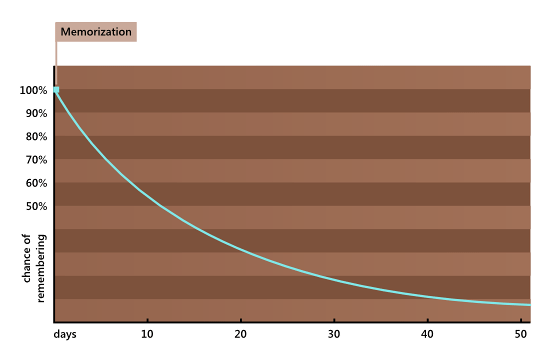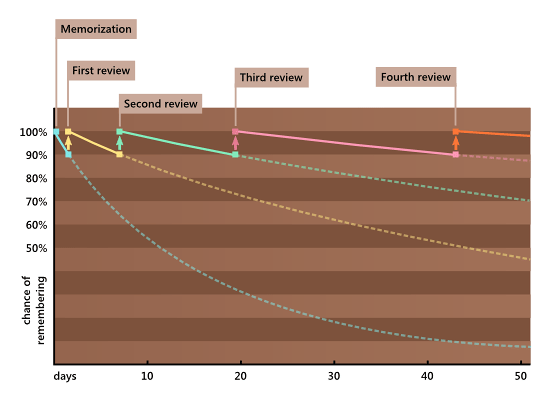Introduction to spaced-repetition software (SRS)
Have you noticed how your vocabulary never seems to increase? You go to an English class, and you come back with 30 new words in your notebook. You learn these words. Next week your teacher gives you 30 new words. You learn the new words, but... you forget the 30 words from last week. So instead of 60 new words, you know 30 again. What a nightmare.
What can you do to help yourself and make progress? There is only one way. You have to do something to stop forgetting the words that you learn. How? You have to start reviewing them.
The notebook approach
Here’s an idea that a lot of people have: When you learn a new word, write it down in a notebook. Every few days, open the notebook and review all the words that you’ve learned. This works well at first — you’re no longer forgetting everything you learn.

Unfortunately, there is a catch: vocabulary notebooks get large pretty quickly. After a few months, the size of your notebook will probably exceed 1,000 words. At 4 seconds per review, it will take over an hour to review all the words! This is why everyone stops reviewing their notebook soon after they start. It starts off well, but then it becomes hell. (Hey, that rhymes!)
If only there was a smarter way to keep English words in your memory, without ending up in “review hell”. Well, guess what? There is. It’s called spaced-repetition software — SRS for short.
How does spaced-repetition software (SRS) work?
-
You add some English words to your SRS. In order to do this, you create items. An item has two parts: the question (Q) and the answer (A), for example:
- Q
- the mother of your husband or wife
- A
- mother-in-law
(This is a very simple item, and there are other kinds.)
-
Every day, you run your SRS. The software gives you some items to review (different items every day). For example, if you added 50 words to your SRS, on Monday you may review 5 words, on Tuesday — another 4 words, etc.
The colossal advantage of SRS is that, instead of reviewing all your vocabulary every time (as in the notebook method), you review only a small portion of it. This is possible because spaced-repetition software knows which words you remember well and which words you remember poorly. Because it knows that, it doesn’t waste your time with things you know well. You only review things you really need to review — things that are in danger of being forgotten.
The results are quite dramatic: It becomes possible to keep thousands of words and phrases in your memory while spending only 10 minutes a day on reviews. It’s like adding a hard drive to your brain!
How does the SRS know which words need to be reviewed?
As you use your SRS, it collects information about your memory. Every time you review a word, you give yourself a grade — this grade tells your SRS how easy it was for you to recall the word. For example, if you recalled a word without hesitation, you would give yourself a 5; if you recalled it with great difficulty, you would give yourself a 3. This data is fed to a complicated mathematical model, which calculates how long you will remember each word. (Note that the model is statistical, rather than exact — it doesn’t know the exact day when you will forget a word, but it knows, for example, that you will remember it for another 30 days with 90% probability.)
The memory model in spaced-repetition software is based on scientific research into human memory. The crucial finding is that memories get stronger with each review. For example, after you learn a new word, you may remember it for 2 days (with, say, 90% probability). If you review it after 2 days, you will remember it for 5 more days. If you review it after those 5 days, you’ll remember it for 10 more days. Then, for 20 more days. And so on. The time between reviews gets longer and longer.
The line below is called a forgetting curve. Let me explain how it works. Suppose you learn a new word on day 0 and you never review it. The forgetting curve shows you the probability that you would remember this word on each day afterwards. For example, after 2 days, it is about 90%, but after 20 days it’s only about 30%. On day 50, the probability of successful recall is only 10% — the word is almost certainly forgotten. (The actual numbers depend on the difficulty of the word.)

Here’s what happens if you use an SRS. The SRS makes you review the word when the probability (chance) of remembering it is still high (usually 90%). After each review, the memory of the word becomes stronger: the probability of recall drops more slowly over time (the forgetting curve is flatter). In other words, forgetting is slowed down.

Two more things to notice here:
- At all times, your chance of remembering the word is between 90% and 100%. The SRS never lets it fall below 90%. This simply means that you always remember the word (with a very high probability).
- In an SRS, you review items at increasing intervals instead of reviewing them every couple of days (as in the notebook method). So you achieve the same effect with a much smaller number of reviews.
What happens during a review?
Reviews in SRS are called repetitions. Here’s what happens during a repetition:
-
The SRS shows you the question, for example:
- Q
- the mother of your husband or wife
- A
- You answer the question (you think about it or you say it). You do not type the answer on your keyboard.
-
The SRS shows you the correct answer:
- Q
- the mother of your husband or wife
- A
- mother-in-law
- You compare your answer with the correct answer, and you give yourself a grade — for example, bad, good or very good. The grade tells the SRS how well you remember the word.
- The SRS decides when you should review the item again. This is called repetition spacing. From your grade, your previous grades for this item, and other statistics, the SRS is able to calculate how long you will remember the word. It then sets the date of the next repetition. The date is set to guarantee a very high probability of successful recall at the next repetition.
What does an everyday session with an SRS look like?
Your everyday SRS session may look like this:
- Review the words planned by your SRS for today. Usually, the number of words that you review every day is very small. For example, if you have 8,000 English words in your SRS, you may have to review only 40 words per day.
- Review difficult words again. This is called final drill. You review all the words for which you got a grade of 3 or less. You review every word until you get at least a 4.
- Memorize new words. You learn words for the first time. You will review these words in a few days.
- Add new words. You can use a dictionary to make your own items with a question and an answer.
How do I add new items to my SRS?
You copy & paste example sentences, words and phonetic transcriptions from an English dictionary to your SRS. Instead of copying example sentences from a dictionary, you can also copy them from books, movies, videogames etc.
There are many ways to make SRS items. The simplest type of item looks like this:
- Q
- They’re always squabbling over money.
- A
-
squabble /'skwa:b.l/
= to argue about something unimportant
This is called a sentence item. The “question” is a sentence with an interesting word or phrase (here: squabble over something). This sentence can come from a dictionary, a book, a website, etc. When you see the sentence, you have to think about its meaning and pronunciation. Then, you read the pronunciation and definition in the answer field — this helps you check your knowledge. Finally, you give yourself a grade, depending on how well you remembered the meaning and pronunciation.
Another type of item is called a definition-word item:
- Q
- = to argue about something unimportant
- A
-
squabble /'skwa:b.l/
They’re always squabbling over money.
Here, the question is a definition. When you see it, you have to say or think the right word. Then, you check your answer and read the example sentence. Finally, you give yourself a grade for your answer.
What are the advantages of SRS?
You can remember (almost) anything you choose. When you read a word in a book or hear it in a movie, you never know if it will stick in your memory. When you add a word to your SRS, you know it will stay with you forever. (Typically, an SRS lets you remember about 95% of the words you have added.) This gives you a nice feeling of security. Although it takes effort to add words to your SRS, the effort is never wasted.
You don’t waste time on the easy stuff. You only review the words which you have almost forgotten. Your SRS only asks you the difficult questions, so you do not waste time on the easy ones. With SRS, you are always spending the minimum amount of effort on learning.
It takes less and less of your time. Because the time between repetitions gets longer, your workload (the number of daily repetitions) keeps decreasing. The longer you use your SRS, the less time it takes to keep a set of words in your memory. For example, after a year of using an SRS, it will take less than 10 repetitions a day to keep 2,000 words in your memory.
What results can I expect?
After adding about 1,000–2,000 items to your SRS, you should begin to notice big changes in your English. Here are some goals that an SRS can help you achieve:
- Increase your vocabulary power. When I started using an SRS (SuperMemo), the first thing I noticed was a quick improvement in my English vocabulary. Almost immediately, I started using new, interesting words when speaking and writing — words like devour, appalling, or live down. In one hour, you can add about 30 new words to your SRS. You can start using these words immediately — at your next English class, in your next e-mail message, etc. Try it — it’s fun to use new skills!
- Understand books, websites, movies, TV shows etc. With your growing vocabulary, reading and listening to English will become more and more pleasant. You will notice words from your SRS everywhere — in books, movies, videogames, etc. Whenever you see a word that you have added to your SRS, you will feel good because you will have proof that you’re making progress.
- Ace your tests. When I was in high school, I hated cramming for many hours before a test. After I started SRSing in high school, cramming became history for me. Instead, I was learning the SRS way — when the teacher gave us some new words, I would add them to my SRS immediately and I would do some repetitions every day. It was a completely new way of learning. The difference was especially obvious right before a test: everyone was stressed out, studying nervously from their opened notebooks and quizzing each other on vocabulary. But the SRS users — me and a few other people — were just sitting there relaxed, talking to each other. There was no reason to worry: we had already put the words in our memory. It almost felt like cheating. Of course, we would all get A’s for the test.
- Impress your teacher and your friends. In an English class, nobody ever remembers vocabulary from last month. That is, nobody except you, if you use an SRS. With spaced-repetition software, you will remember not only vocabulary from last month, but even from last year. While other students keep forgetting what they learn, you will keep reaching higher and higher levels. I guarantee your teacher will be amazed at your progress, and so will your friends. Soon they’ll be coming to you with their English questions!
- Improve your grammar. Example sentences in SRS items are very effective input because you see them again and again. After some time, you will get used to the grammar structures in example sentences. They will become natural for you. In addition to example sentences, you can add special items which test your grammar knowledge.
- Learn the pronunciation of English words. You can add pronunciations to your normal items or use special items for learning the pronunciations of English words. This is very important because English pronunciation is irregular — many words (even basic ones) have very surprising pronunciations. If you add pronunciations to your SRS, you will become a more confident speaker because you will no longer have to wonder how to pronounce hundreds of English words like cover, won’t or foreign.
- Eliminate your mistakes. There’s a very effective technique for dealing with mistakes: Whenever someone corrects your English sentence, add the correct version to your SRS as a sentence item. Your SRS will make you review the correct version many times. Eventually, it will replace the incorrect version in your mind.
Can an SRS help improve my motivation?
Yes. Spaced-repetition software has two psychological advantages over other learning methods, such as pure input-based learning (only reading/listening) or English classes:
- Quantifiable goal. Runners measure the distance that they’ve run. People on a diet measure their weight. If you express a goal as a number, it becomes more concrete and more powerful. You will keep thinking about that number and you will want that number to go up. If it goes up, you’ll get a feeling of accomplishment. “I ran 4.5 km today” is much more powerful than “Today I ran a pretty long distance”. An SRS lets you use the power of quantifiable goals for learning English. It lets you say to yourself: “I have memorized 2123 words”, “I will add 20 new words today” or “I will get to 2500 by the end of the month”.
- Feeling of security. With an SRS, you know that every word you add will stay in your head, so you always feel that your work is useful and productive.
Do I have to add items myself?
Although making your own items is the best way to use spaced-repetition software, you can use SRS content made by other people and companies. The biggest advantage of ready-made SRS collections is quite obvious — they save you a lot of time. The biggest problem is that it’s not easy to find high-quality collections. However, ready-made SRS content can be a good idea if you have little time or little computer skills, especially if you are a beginner (the quality doesn’t matter so much if you’re just starting to learn English).
How can I start using SRS?
Get an SRS application and start adding items!
Further reading
- Article about the father of SuperMemo, the first spaced-repetition software (Wired Magazine)
- My personal experiences with SuperMemo